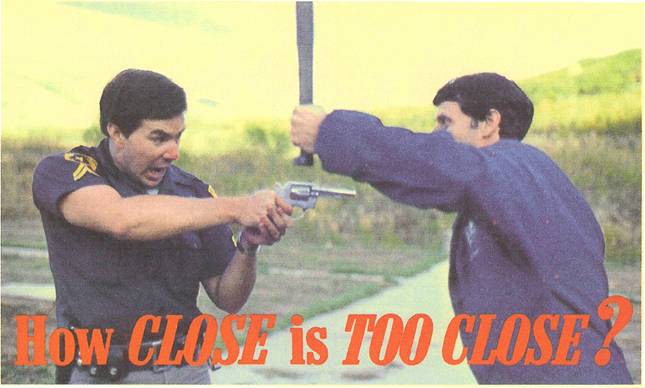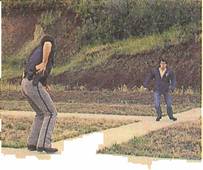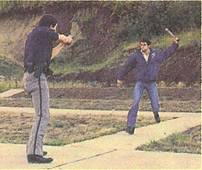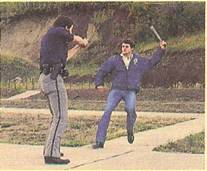 HOW CLOSE IS TOO CLOSE?
HOW CLOSE IS TOO CLOSE?
by Dennis Tueller
The "good guy" with the gun against the "bad guy" with the knife (or machete, axe, club, tire-iron,
etcetera). "No contest", you say. "The man with the gun can't lose." Or can he? A great deal depends on
his ability with that gun and the proximity of his opponent.
If, for example, our hero shoots his would-be attacker at a distance of 20 yards, he loses. Not the
fight, you understand, but most probably his freedom because he will almost certainly be charged with
murder. The only thing that justifies your shooting another human being is the immediate need to stop
him from trying to kill you (or someone else), remember?
If, on the other hand, our hero waits to fire until his attacker is within obvious striking distance,
he may still lose. His shots may not stop his attacker instantly enough to keep him from using his knife.
So, what is the answer - just how close is too close?
Consider this. How long does it take for you to draw your handgun and place two center hits on a man-size
target at seven yards? Those of us who have learned and practiced proper pistolcraft techniques would say
that a time of about one and one-half seconds is acceptable for that drill.
With that in mind, let's consider what might be called the "Danger Zone" if you are confronted by an
adversary armed with an edged or blunt weapon. At what distance does this adversary enter your Danger
Zone and become a lethal threat to you?
We have done some testing along those lines recently and have found that an average healthy adult male
can cover the traditional seven yard distance in a time of (you guessed it) about one and one-half seconds.
It would be safe to say then that an armed attacker at 21 feet is well within your Danger Zone.



As the photo series illustrates, even if your draw and shots are perfect, you are cutting things awfully close
(no pun intended). And even if your shots do take the wind out of his sails, his forward momentum may carry
him right over the top of you, unless, of course, you manage to get out of his way. And if you are confronted
with more than one assailant, things really get tricky. So what's a pistol-packing person to do?
Having analyzed the problem, the following suggestions come to mind: First, develop and maintain a healthy
level of tactical alertness. If you spot the danger signs early enough, you can probably avoid the
confrontation altogether. A tactical withdrawal (I hesitate to use the word "retreat") may be your
best bet, unless you're anxious to get involved in a shooting and the consequent legal hassles which
are sure to follow.
Next, if your "Early Warning System" tells you that a possible lethal confrontation is imminent, you want to
place yourself in the best tactical position available. You should move to cover (if there is any close at
hand), draw your weapon, and start to plan your next move.
Why use cover, you may wonder, if your attacker is using only a knife? Because you want to make it hard for
him to get to you. Anything between you and your attacker (trash cans, vehicles, furniture, etcetera) that
slows him down buys you more time to make the appropriate decisions, and, if it becomes necessary, more time
to place your shots.
I suggest you draw your weapon as soon as the danger clearly exists. There is no point in waiting until the
last possible second to play "Quick-Draw McGraw" if you recognize the threat early on. Also, the sight of
your "Equalizer" may be sufficient to terminate the action then and there.
The purpose of the pistol is to stop fights, and whether it does so by dropping a thug in his tracks, or
by causing him to turn tail and run, your goal is accomplished, is it not?
At this point it might be advisable to issue a verbal challenge such as, "Stop"', "Don't move", or "Drop
your weapon!" It may work, and even if it doesn't you'll be developing your legal case for self-defense
by showing that you did everything you could to prevent a shooting. If all goes according to plan, the
odds are that by now you will no longer have a problem, your attacker having remembered he had a more
pressing engagement elsewhere.
But, as we all know, things seldom go according to plan and the ideal circumstances previously described
are probably not the norm. For example, if this goon tries to throw his knife (or other weapon) at you,
what do you do then?
Realistically, knife-throwing is something of a gallery trick requiring specially balanced knives and a
pre-measured distance to the target. Suffice it to say, however, that if your attacker is within effective
throwing range he will almost surely have encroached into your Danger Zone. This throwing business does
create something of a timing problem, for, if you fire after he has thrown his weapon, you may have
difficulty convincing a jury that you fired in self-defense since technically you were not in jeopardy
if your former attacker is no longer in possession of a deadly weapon. Something to consider, and just
one more reason to use cover if it is available and time permits.
Sometime, of course, despite your best efforts, you could find you are suddenly, at close quarters, the
intended victim of some lunatic slasher. If you are an expert in one of the many martial arts, you may
opt to go at it hand-to-hand, and if you are in this category you do not need advice from me on how to
do it. So, we'll get back to the use of the handgun for solving the problem. What it all comes down to
now is your ability to smoothly and quickly draw your pistol and hit your adversary, and do it all
reflexively. And the only way to develop these reflexes is through consistent, repetitive practice,
practice, practice.
Practice so the right move comes automatically.
One thing you should practice, with this kind of encounter in mind, is the step-back technique in which
you take a long step to the rear as you draw. This puts another three to four feet between you and your
attacker, which may be just enough to make the difference.
Remember, the greater your skill with your weapon, the smaller your Danger Zone will be, but only if that
skill is coupled with good mental conditioning, tactical planning and alertness, because no amount of skill
will do you any good unless you know that you're in trouble.
Skill at arms and proper mental attitude. that's the combination that will make you the winner in a "Close
Encounter of the Cutting Kind."
My interjected note from another page (regarding the above article):
There is no "21 foot rule." Sgt. Dennis Tueller performed a demonstration showing how quickly a man can run 21
feet, and in 1983, the results were printed in S.W.A.T. magazine.
During the demonstration, Sgt. Tueller showed how quickly a person could run 21 feet. He did not show, nor did
he in any way state, that 21 feet is some magic safety distance, nor did he say someone 21 feet or further away
can't be a threat. What he did show was the average person can run 21 feet very quickly, therefore a person 21
feet away with a contact weapon can still be a threat to many people.
His exact quote was "It would be safe to say then, that an armed attacker at 21 feet is well within your danger
zone." So, 21 feet away is "well within" your danger zone. Not "21 feet away, and you're safe." Somehow, however,
people have morphed that into "a man 21 feet away is not a threat" or the non-existant "21 foot rule" which
supposedly says 21 feet is a safety zone, and that is not what Sgt. Tueller's demonstration showed, nor is it
what he stated. I have to wonder how these things get so incredibly miscontrued. If you're interested in
actually reading the article, see this link. How close is too close?:
ADDED NOTE:
I decided later to add the following note, however, for purposes of my point, the above paragraph regarding the
"21 foot rule" still stands as-is.
There actually is a 21 foot rule, but only colloquially, because of popular (albeit incorrect) usage of the phrase.
As stated above, many people incorrectly state that Tueller proved that 21 feet is a safe distance, and he did no
such thing, nor did he claim to have proved that. In fact, he claimed the exact opposite, that 21 feet is "within
your danger zone." The fact that many people repeat incorrect information does not make that information correct.
Back:




